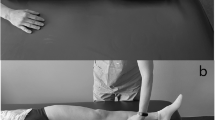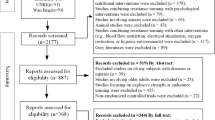Abstract
Study design:
Within-participant randomised controlled trial.
Objectives:
To determine whether strength training combined with usual care increases strength in partially paralysed muscles of people with recent spinal cord injury (SCI) more than usual care alone.
Settings:
SCI units in Australia and India.
Methods:
Thirty people with recent SCI undergoing inpatient rehabilitation participated in this 12-week trial. One of the following muscle groups was selected as the target muscle group for each participant: the elbow flexors, elbow extensors, knee flexors or knee extensors. The target muscle on one side of the body was randomly allocated to the experimental group and the same muscle on the other side of the body was allocated to the control group. Strength training was administered to the experimental muscle but not to the control muscle. Participants were assessed at baseline and 12 weeks later. The primary outcome was maximal isometric muscle strength, and the secondary outcomes were spasticity, fatigue and participants’ perception of function and strength.
Results:
There were no dropouts, and participants received 98% of the training sessions. The mean (95% confidence interval (CI)) between-group difference for isometric strength was 4.3 Nm (1.9–6.8) with a clinically meaningful treatment effect of 2.7 Nm. The mean (95% CI) between-group difference for spasticity was 0.03/5 points (−0.25 to 0.32).
Conclusion:
Strength training increases strength in partially paralysed muscles of people with recent SCI, although it is not clear whether the size of the treatment effect is clinically meaningful. Strength training has no deleterious effects on spasticity.
Similar content being viewed by others
Log in or create a free account to read this content
Gain free access to this article, as well as selected content from this journal and more on nature.com
or
References
Snoek GJ, Ijzerman MJ, Hermens HJ, Maxwell D, Biering-Sorensen F . Survey of the needs of patients with spinal cord injury: impact and priority for improvement in hand function in tetraplegics. Spinal Cord 2004; 42: 526–532.
Manns PJ, Chad KE . Components of quality of life for persons with a quadriplegic and paraplegic spinal cord injury. Qual Health Res 2001; 11: 795–811.
Collinger JL, Boninger ML, Bruns TM, Curley K, Wang W, Weber DJ . Functional priorities, assistive technology, and brain-computer interfaces after spinal cord injury. J Rehabil Res Dev 2013; 50: 145–160.
Harvey LA . Physiotherapy rehabilitation for people with spinal cord injuries. J Physiother 2016; 62: 4–11.
Garber CE, Blissmer B, Deschenes MR, Franklin BA, Lamonte MJ, Lee IM et al. American College of Sports Medicine position stand. Quantity and quality of exercise for developing and maintaining cardiorespiratory, musculoskeletal, and neuromotor fitness in apparently healthy adults: guidance for prescribing exercise. Med Sci Sports Exerc 2011; 43: 1334–1359.
Mulroy SJ, Thompson L, Kemp B, Hatchett PP, Newsam CJ, Lupold DG et al. Strengthening and optimal movements for painful shoulders (STOMPS) in chronic spinal cord injury: a randomized controlled trial. Phys Ther 2011; 91: 305–324.
Taylor NF, Dodd KJ, Damiano DL . Progressive resistance exercise in physical therapy: a summary of systematic reviews. Phys Ther 2005; 85: 1208–1223.
Harvey LA, Fornusek C, Bowden JL, Pontifex N, Glinsky J, Middleton JW et al. Electrical stimulation plus progressive resistance training for leg strength in spinal cord injury: a randomized controlled trial. Spinal Cord 2010; 48: 570–575.
Glinsky J, Harvey L, Korten M, Drury C, Chee S, Gandevia SC . Short-term progressive resistance exercise may not be effective at increasing wrist strength in people with tetraplegia: a randomised controlled trial. J Physiother 2008; 54: 103–108.
Jayaraman A, Thompson CK, Rymer WZ, Hornby TG . Short-term maximal-intensity resistance training increases volitional function and strength in chronic incomplete spinal cord injury: a pilot study. J Neurol Phys Ther 2013; 37: 112–117.
Folland JP, Williams AG . The adaptations to strength training: morphological and neurological contributions to increased strength. Sports Med 2007; 37: 145–168.
Ginis KA, Hicks AL, Latimer AE, Warburton DE, Bourne C, Ditor DS et al. The development of evidence-informed physical activity guidelines for adults with spinal cord injury. Spinal Cord 2011; 49: 1088–1096.
Kraemer WJ, Ratamess NA . Fundamentals of resistance training: progression and exercise prescription. Med Sci Sports Exerc 2004; 36: 674–688.
Sisto SA, Dyson-Hudson T . Dynamometry testing in spinal cord injury. J Rehabil Res Dev 2007; 44: 123–136.
Sharp SA, Brouwer BJ . Isokinetic strength training of the hemiparetic knee: effects on function and spasticity. Arch Phys Med Rehabil 1997; 78: 1231–1236.
Hartkopp A, Harridge SDR, Mizuno M, Ratkevicius A, Quistorff B, Kjaeer M et al. Effect of training on contractile and metabolic properties of wrist extensors in spinal cord-injured individuals. Muscle Nerve 2003; 27: 72–80.
Barrett B, Brown D, Mundt M, Brown R . Sufficiently important difference: expanding the framework of clinical significance. Med Decis Making 2005; 25: 250–261.
Newson R . Parameters behind ‘nonparametric’ statistics: Kendall's tau, Somer's D and median differences. Stata J 2002; 2: 45–64.
Lee M, Carroll TJ . Cross education: possible mechanisms for the contralateral effects of unilateral resistance training. Sports Med 2007; 37: 1–14.
Campos GE, Luecke TJ, Wendeln HK, Toma K, Hagerman FC, Murray TF et al. Muscular adaptations in response to three different resistance-training regimens: specificity of repetition maximum training zones. Eur J Appl Physiol 2002; 88: 50–60.
Smania N, Picelli A, Munari D, Geroin C, Ianes P, Waldner A et al. Rehabilitation procedures in the management of spasticity. Eur J Phys Rehabil Med 2010; 46: 423–438.
Morris SL, Dodd KJ, Morris ME . Outcomes of progressive resistance strength training following stroke: a systematic review. Clin Rehabil 2004; 18: 27–39.
Mandalidis D, O'Brien M . Relationship between hand-grip isometric strength and isokinetic moment data of the shoulder stabilisers. J Bodywork Mov Ther 2010; 14: 19–26.
Lord JP, Aitkens SG, McCrory MA, Bernauer EM . Isometric and isokinetic measurement of hamstring and quadriceps strength. Arch Phys Med Rehabil 1992; 73: 324–330.
Acknowledgements
We thank all our participants and staff from the SCI units in Australia and India who contributed to the trial. We thank the workshop staff at Neuroscience Research Australia who designed and constructed the rig used for our strength measurements. Simon Gandevia is supported by the National Health and Medical Research Council of Australia. Prince of Wales Hospital Foundation and National Health and Medical Research Council of Australia sponsored this study.
Author information
Authors and Affiliations
Corresponding author
Ethics declarations
Competing interests
The authors declare no conflict of interest.
Rights and permissions
About this article
Cite this article
Bye, E., Harvey, L., Gambhir, A. et al. Strength training for partially paralysed muscles in people with recent spinal cord injury: a within-participant randomised controlled trial. Spinal Cord 55, 460–465 (2017). https://doi.org/10.1038/sc.2016.162
Received:
Revised:
Accepted:
Published:
Issue date:
DOI: https://doi.org/10.1038/sc.2016.162
This article is cited by
-
Multi-omics uncovers immune-modulatory molecules in plasma contributing to resistance exercise-ameliorated locomotor disability after incomplete spinal cord injury
Genome Medicine (2025)
-
Physiotherapy interventions for the respiratory management of people with spinal cord injury: recommendations from an Australian and New Zealand clinical practice guideline
Spinal Cord (2025)
-
An Australian and New Zealand clinical practice guideline for the physiotherapy management of people with spinal cord injuries
Spinal Cord (2025)
-
Robotic technology (ROBERT®) to enhance muscle strength in the hip flexor muscles following spinal cord injury: a feasibility study
Spinal Cord Series and Cases (2024)
-
Using the benefit-harm trade-off method to determine the smallest worthwhile effect of intensive motor training on strength for people with spinal cord injury
Spinal Cord (2024)



